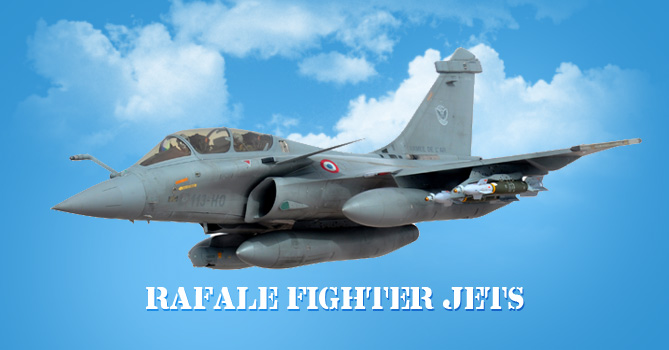On 25 January 2016, India finally signed the Inter-Governmental Agreement (IGA) with France to purchase 36 Rafale Fighter Jets. The final price, however, is yet to be finalized and is likely to take another month.
The signing of the agreement comes after yearlong hectic negotiations with France, when PM Modi had announced India’s decision to scrap the 126 aircraft deal with Dassault Aviation, manufacturers of Rafale Fighter jets, that included some aircraft to be bought in fly-away condition and the rest manufactured under licence in India.
Since both sides could not reach an agreement, it was decided to scrap the deal with Dassault and enter into a government-to-government negotiation. The decision by India to buy 36 aircraft in fly away condition did surprise many on both sides.
Why is the Rafale deal so crucial to France?
The signing of the deal comes as a big relief to France and President François Hollande in particular, as France grapples with recession and near stagnant growth in EU.
The Rafale Fighter aircraft was born out of a decision to walk out of the Eurofighter joint development programme that included several EU countries. France then took the decision to go it alone and develop a Medium Multi-Role Combat Aircraft (MMRCA) in a move that was fraught with commercial risk, if not a technical one.
Once developed, after incurring significant cost, the Rafale fighter was soon competing for international sales with the Eurofighter Typhoon. In a market dominated by the likes of US and Russia, France was finding it hard to find buyers for the Raphael, as many potential clients showed greater preference for the Eurofighter.
Once India floated an RFQ for the MMRCA jet to replace its ageing fleet of MIG 21 and MIG 27 aircraft in 2007, Rafale joined Eurofighter Typhoon, Swedish Gripen from SAAB, Russian MIG 35, and the American F-16 and F18 jets, in a fiercely fought race.
After extensive technical trials in all weather conditions, the Indian Air Force rated the Rafale as the most suited aircraft, as per Indian requirement, and ranked the Eurofighter Typhoon second. In the commercial bid, Rafale beat the Eurofighter on Life Cycle Cost (LCC) to emerge the final winner.
During the process of selection, Egypt and Qatar decided to purchase the Rafale fighter jet, which gave the aircraft a new lease of life, as France was in the process of curtailing production of the Rafale on account of lack of orders. The initial Indian decision to buy 126 aircraft brought France right back into the fighter jet business.
However, with negotiations getting bogged down and India now significantly reducing the number of aircrafts to 36, France now needs the deal more than ever, and therefore, the French government has been aggressively pushing India to finalize the deal.
Politically, President François Hollande will return a satisfied man having inked the Rafale jet deal, along with 14 other commercial MOUs, which include supply of six nuclear reactors for the Jaitapur Nuclear Power Project in Maharashtra.
Other agreements include the field of space, smart cities, transportation and industry.
Why is Rafale so crucial for India?
India has largely depended on Russia for its military equipment and today a large part of military hardware in all three services is from the Soviet-era and obsolete. After the break-up of the Soviet Union, India has been struggling with increasing technical problems and availability of spares.
The Indian Air Force too is still largely operating mostly Soviet-era aircraft, with the exception of the Sukhoi 30 MKI, which is a state-of-art aircraft built by Russia. The Indian defence is based on a simultaneous war scenario on both the Eastern and Western fronts. With China investing heavily in modernizing its force, India has been forced to increase its investment and modernize its three arms to levels that ensure adequate deterrence measures on both fronts.
The Indian Air Force has a sanctioned strength of 45 squadrons. However, the aircraft strength is now down to 34 squadrons leaving the air defence capability vulnerable. The Sukhoi 30 MKI is a heavy, all weather, long range fighter aircraft that fulfills a certain role. MIG 21 is a single engine light aircraft capable of air interception roles but is now obsolete, while MIG 27 is essentially a ground attack aircraft, again obsolete.
For light weight air interception role, India has developed the Tejas, which is a single engine aircraft that can be configured for multi-role operations and support the heavier Sukhoi 30 jet in missions. India is in the process of developing the Mark II version of the Tejas that will have greater engine and performance capabilities.
The country now plans to develop a 5th generation Advanced Medium Combat Aircraft (AMCA). Since this aircraft is expected to fulfill the role of an MMRCA but is likely to take at least another 10-15 years before it is fully operational, India has decided to buy the Rafale to fulfill its immediate need.
India urgently requires a single medium range all-weather multi-role combat aircraft that would fulfill air superiority, air-to-ground, deep strike and Naval combat operations, and Rafale is expected to fulfill this need. Therefore, the Rafale deal is as critical for India, as it is for France, though for different reasons.
Contradiction with Make in India programme
India’s decision to buy off-the-shelf 36 Rafale Fighter aircraft has surprised many in India and also in France. The India Air Force had made a force projection of 126 MMRCA to meet its operational needs. The decision to buy 36 aircraft comes nowhere close in fulfilling this need.
Each new aircraft introduced carries a tremendous cost to operationalize and maintain the aircraft. Pilots have to be trained, maintenance protocols have to be established, technology transfer and absorption needs to take place, besides a new line of supply and logistics for maintenance and spares needs to be established.
Since a fighter aircraft’s operational life is expected to be at least 30-40 years, it is essential to take decisions keeping in mind the long-term plans and the consequential cost. In 80s, India acquired Mirage 2000 aircraft from France. While the aircraft was the latest in its time, the cost of maintaining a small inventory significantly increased its LCC. The same fate may await the Rafale if the numbers are restricted to 36.
Furthermore, off-the-shelf purchase of Raphael directly contradicts India’s plan to promote Make in India, especially in Defence. Indian defence planners are caught between the decision to build Rafale in larger numbers in India or take the risk of investing in the AMCA programme, which may take time but will not only be technically strong but also cost-effective over any international aircraft, once it is operational.
That’s a tough call to make. But for now, it’s Rafale for the Indian fighter pilots.






